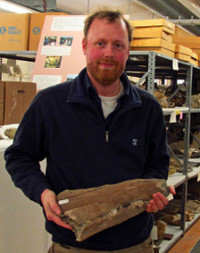
Fossil Focus: Thalattosuchia
by Mark T. Young*1, Sven Sachs2 & Pascal Abel3
Introduction:
To most people, crocodilians are large-bodied carnivores that have been unchanged since the age of the dinosaurs. However, during their 230 million-year history, modern crocodilians and their extinct relatives evolved a stunning diversity of body plans, with many looking very different from those alive today (crocodiles, alligators, caimans and gharials).
The first crocodylomorphs (the term used for living crocs and various fossil groups) are known from the Late Triassic Period, approximately 235 million to 237 million years ago. These animals lived on land and looked much more like a greyhound than a crocodile, with long legs and a skull that was deep like that of a meat-eating dinosaur, rather than flattened like that ...
